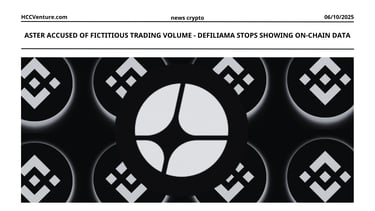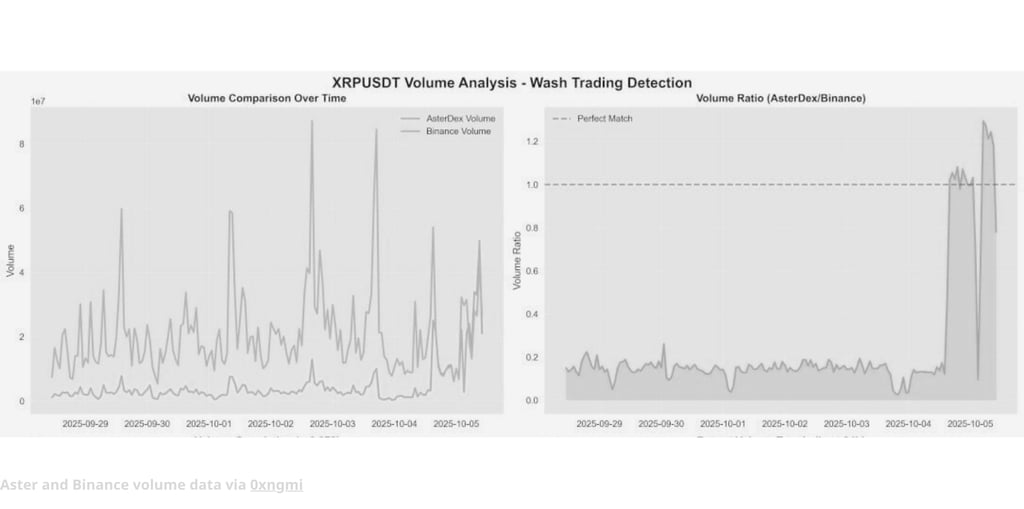Aster Accused of Fake Trading Volume - Defiliama Stops Showing Data
DeFiLlama announced that it will temporarily stop displaying trading volume data for Aster, a decentralized exchange (DEX) protocol, pending further verification of potential wash trading activity.
10/6/20252 min read


Notice of temporary suspension of Aster data display
DeFiLlama, which removed Aster DEX’s perpetual futures trading volume statistics from its rankings, cited clear warning signs of potential wash trading, similar to Binance’s activity with a near-perfect 1:1 ratio on major trading pairs like XRPUSDT.
The move, spotted by DeFiLlama head Andy Liu early Monday morning, immediately caused a more than 10% drop in Aster’s native token $ASTER, falling from a low of $2.10 to $1.85 amid a 24-hour trading volume of $1 billion.
In a criminal sector already bloated with $20 billion in daily flows, this isn’t just FUD, it’s a stark reminder of DeFi’s fatal flaw. Inflated metrics prop up valuations until the rug is pulled out. As rivals like Hyperliquid reclaim the top spot unchallenged, Aster’s Binance-related strategy is at risk of being disrupted, potentially eroding confidence in BNB Chain’s DEX meta and accelerating the purge of aggregated liquidity operations.


The incident caused great impact
Over the past few months, Aster has attracted attention for reporting extremely high daily trading volumes, often surpassing larger DEX platforms such as Uniswap, PancakeSwap, and Curve. While Aster positions itself as a next-generation DEX that offers liquidity mining, dynamic fees, and cross-chain trade execution, the discrepancy in its volume-to-liquidity ratio has drawn scrutiny from data analysts.
Wash trading — a practice in which traders or automated bots repeatedly buy and sell the same asset to artificially inflate trading activity — remains a persistent problem in both centralized and decentralized markets. Inflated figures can distort market share rankings, TVL (Total Value Locked) comparisons, and token valuations, misleading both investors and protocols.
DeFiLlama's delisting of Aster's trading volume data reflects an industry-wide effort to ensure data reliability, especially as institutional investors increasingly rely on aggregator platforms for market insights.
The $10 Billion Shadow of Wash Trading
This story exposes a chronic problem: Wash trading inflates DEX volume by 30-50%, according to Chainalysis, supporting fixed-value investments (FDV) while eroding trust — remember FTX’s $9 billion illusion.
For Aster, it's existential: As a "CeDeFi" hybrid, its Binance ties amplify suspicion, potentially driving capital to purer companies like Lighter (#2 after delisting) or dYdX. BNB Chain risks spillover, with TVL growth stagnating at 15% quarter-on-quarter amid increased scrutiny.
Economically, this is a liquidity test: Aggregate trading volume distorts yields (Aster’s 5-7% annualized yield (APY) is now in doubt), discouraging institutions from pursuing the $15 billion in TVL investments. The Fed’s steady interest rates limit risk appetite, but election deregulation could force disclosure—similar to the Clarity Act.
Disclaimer: The information presented in this article is the author's personal opinion in the cryptocurrency field. It is not intended to be financial or investment advice. Any investment decision should be based on careful consideration of your personal portfolio and risk tolerance. The views expressed in this article do not represent the official position of the platform. We recommend that readers conduct their own research and consult with a professional before making any investment decisions.
Explore HCCVenture group
HCCVenture © 2023. All rights reserved.


Connect with us
Popular content
Contact to us
E-mail : holdcoincventure_contact@hccventure.com
Register : https://linktr.ee/holdcoincventure
Disclaimer: The information on this website is for informational purposes only and should not be considered investment advice. We are not responsible for any risks or losses arising from investment decisions based on the content here.


TERMS AND CONDITIONS • CUSTOMER PROTECTION POLICY
ANALYTICAL AND NEWS CONTENT IS COMPILED AND PROVIDED BY EXPERTS IN THE FIELD OF DIGITAL FINANCE AND BLOCKCHAIN BELONGING TO HCCVENTURE ORGANIZATION, INCLUDING OWNERSHIP OF THE CONTENT.
RESPONSIBLE FOR MANAGING ALL CONTENT AND ANALYSIS: HCCVENTURE FOUNDER - TRUONG MINH HUY
Read warnings about scams and phishing emails — REPORT A PROBLEM WITH OUR SITE.
